Anna Hicks* and Jenni Barclay explore how co-producing risk communication strategies with those at risk can catalyse preparatory actions for the impacts of natural hazards
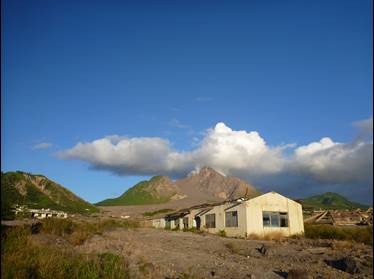 The Soufrière Hills Volcano on Montserrat has been ‘in eruption’ now for over 23 years. In that time, this dynamic natural laboratory has triggered a profusion of research opportunities across the Earth sciences and innovative study crossing the boundaries of traditional academic disciplines. Following its most destructive event in June 1997, scientists used eyewitness accounts to support reconstructions of eruptive sequences at Soufrière Hills. Since then many studies have looked to human experience of events to understand the important drivers behind effective preparedness and response. Effective communication is at the heart of these efforts.
The Soufrière Hills Volcano on Montserrat has been ‘in eruption’ now for over 23 years. In that time, this dynamic natural laboratory has triggered a profusion of research opportunities across the Earth sciences and innovative study crossing the boundaries of traditional academic disciplines. Following its most destructive event in June 1997, scientists used eyewitness accounts to support reconstructions of eruptive sequences at Soufrière Hills. Since then many studies have looked to human experience of events to understand the important drivers behind effective preparedness and response. Effective communication is at the heart of these efforts.
Picture left: View of Soufrière Hills Volcano, Montserrat (April 2017) from the devastated city of Plymouth © Anna Hicks, BGS
Closer collaboration
As the science around disaster risk becomes more citizen-centric, there is a move towards closer collaboration between scientists and citizens, and away from one-way telling of information and extractive methods of knowledge production. Evidence suggests this produces a richer, shared knowledge. Based on recent experiences, we also argue that development of the process of collaboration, and communication around risk topics, is as crucial as development of the communication ‘product’ itself. By process, we mean the practice of communication to understand how we learn (not only what is learned) and how we co-produce knowledge by sharing expertise.
This might sound obvious, but at the beginning of our six-year research project, ‘Strengthening Resilience in Volcanic Areas’ (STREVA), it became clear that there was very little evidence from geoscience research as to whether involving citizens and their own local knowledge might have a strong practical impact on effective risk communication. Back in 2012, as we started our research in Montserrat, we were concerned that many local residents had interview fatigue from journalists and researchers repeatedly asking about their experiences of the eruption. Instead we simply offered a platform for people to share their stories in any way they wished to express themselves. The emotion captured by sharing experience through a song, a picture, or a film in turn evoked emotion in the audience—such powerful narratives were a strong source of knowledge and power to act.
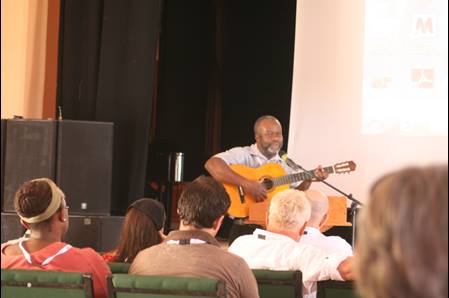 Picture right: A Montserrat resident sharing his experiences of the Soufrière Hills eruption at the STREVA Forensic Workshop (Sept 2012) © David Pyle
Picture right: A Montserrat resident sharing his experiences of the Soufrière Hills eruption at the STREVA Forensic Workshop (Sept 2012) © David Pyle
La Soufriére, St. Vincent When we then started working in nearby St. Vincent, one of the strongest requests from community members and emergency managers was for us to find a means to capture and record the experiences of the generation who had experienced the sudden activity in April 1979, the last time their volcano (another Soufrière) erupted. Valuable information about the consequences of uncertainty, and emergency response during ashfall came tumbling out in those descriptions.
We decided to take film as an example of a communication device and record those experiences, in a way that conveyed some important messages to prepare for a future eruption. It is well documented that film can be used as a powerful and effective hazard education tool, but there was more limited evidence from geophysical hazard research as to the role of film (and storytelling more generally) in intervention strategies aimed at reducing risk to environmental threats. So, we began to explore how we might use film—and the process of making a film—to engage, inform, and ultimately empower people to adapt their behaviour. Our journey started in St. Vincent (see STREVA YouTube film link),and following the film’s success in terms of audience numbers and subsequent engagement in volcanic risk reduction, in 2015 we were asked to capture stories from an eruption in Colombia—an eruption with a volcanic explosivity index of 3, the same size as La Soufrière, but with much more devastating consequences.
Nevado del Ruiz, Colombia
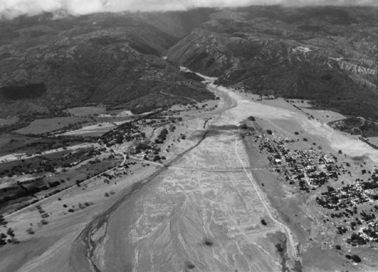
Picture left: An aerial view of what was the town of Armero following the lahars generated by the 1985 eruption of Nevado del Ruiz, Colombia © USGS creative commons
In November 1985, the eruption of Nevado del Ruiz in Colombia shocked the world. Enormous lahars (mudflows) hurtled through ravines spreading into towns and villages around the volcano, killing over 25,000 people. While the contributing factors that caused the disaster were complex, ultimately poor communication was at the heart of the problems, as well as a lack of learning from previous events (many of the towns are built on lahar deposits that destroyed these areas in 1595 and 1845). As the 30th anniversary of the eruption loomed, engaging with a new generation that had no memory of the eruption was imperative. It was also necessary to give space for survivors to tell their stories. The Manizales-based director of geohazards at the Servicio Geologico Colombiano (SGC), Gloria Patricia Cortes remarked, “We [SGC] observed that many of the survivors, or those affected by the eruption of the 13th November 1985, had the need and willingness to tell their stories as an act of catharsis”. The emotional release through storytelling was something we also found from our research in the Caribbean.
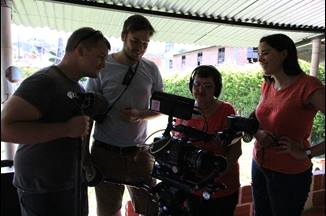
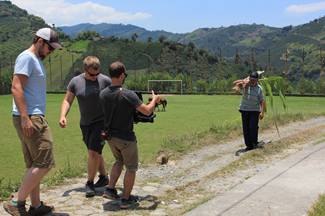
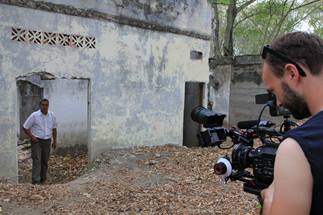
Images above: The STREVA team and professional film company, Lambda Films, collaborating with local community members to tell their story of the 1985 eruption of Nevado del Ruiz (Nov 2015) © Anna Hicks, BGS
A focus on stories and storytellers
Our experiences from St. Vincent ensured that participants of our intended audiences became the leading focus of our new films, guiding the viewer through their experiences of an eruption, the story of recovery, and the challenges of having an active volcano as a neighbour. The storytellers had ultimate control over what was said—potentially affording a representation of past events that more closely resemble the situation for communities at risk—but they also became co-producers of the films, sharing opinions about where to film and what they wanted to show.
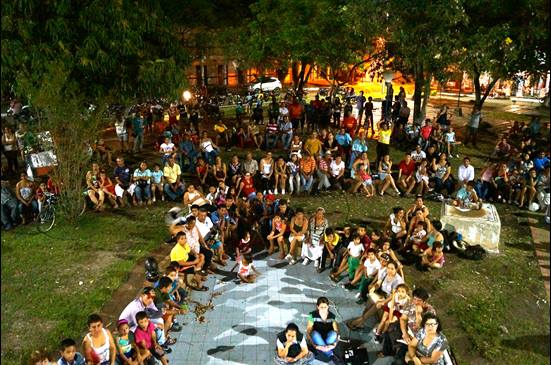
Picture left: Public screening of the Nevado del Ruiz trilogy of films in the town of Lérida, Colombia (Mar 2016). Photo © James Hickey
We edited the films back in the UK, but launched the films in Colombia at several local community-based film screenings. This was particularly important around Nevado del Ruiz as the volcano occupies a huge area and the communities at-risk from future eruptions reside on all sides of the volcano. Further, only sharing online would limit the reach of the films to individuals who had access to internet. Over 700 people attended the screenings. The events presented an opportunity to generate dialogue between scientists and citizens, and between the attendees themselves. Longstanding neighbours and friends began to talk about their experiences during the eruption, sharing personal stories from that tragic day and the months and years’ that followed. The screenings also confirmed our hypothesis that the emotional response to the films could positively guide thinking and behaviour around risk. The powerful narrative thread and imagery had such an influence on affect, this in turn empowered people to use new knowledge (or their own knowledge) and develop preparedness efforts for future eruptions.
A sensitive approach
Given recent events in Guatemala, it is important not to trivialise the power and the deep trauma of those experiences for communities—particularly when they have ended in tragedy. We should not point microphones or cameras immediately at bereaved citizens; descriptions of the Nevado del Ruiz disaster were still powerful and difficult to relate 30 years later, and few people in Montserrat are comfortable discussing the fatal events openly in 1997, even now. But, the recent tragedy has served to remind us that the combination of hazardous volcanic activity with the complex social, cultural and political circumstances surrounding the volcano are what turn an eruption into a disaster. Communication processes that help remind us all of those lethal and difficult combinations-and effective means to unravel and avoid them, must surely enrich all of our understanding.
Authors: Anna Hicks1* & Jenni Barclay2
1. The British Geological Survey, Lyell Centre, Research Avenue South, Edinburgh, EH14 4AP; 2. University of East Anglia, Norwich Research Park, Norwich, Norfolk, NR4 7TJ; *Correspondence: [email protected]
Download the article pdf here
Further reading
Hicks, A., et al. (2017) Risk communication films: Process, product and potential for improving preparedness and behaviour change. International Journal of Disaster Risk Reduction 23: 138-151.
Loughlin, S. C., et al. (2002) Eyewitness accounts of the 25 June 1997 pyroclastic flows and surges at Soufrière Hills Volcano, Montserrat, and implications for disaster mitigation. The eruption of Soufrière Hills Volcano, Montserrat, from 1995 to 1999. T. H. Druitt and B. P. Kokelaar (eds). London, Geological Society, Memoirs 21: 211-230.
Stone, J., et al. (2014) Risk reduction through community-based monitoring: the vigias of Tungurahua, Ecuador. Journal of Applied Volcanology 3(1): 11.
Montserrat activity report: http://www.mvo.ms/pub/SAC_Reports/SAC22-Summary_Report.pdf
The NERC/ESRC-funded STREVA project: http://streva.ac.uk/
STREVA YouTube channel: https://www.youtube.com/user/STREVAProject/videos.
VolFilm channels: https://www.youtube.com/channel/UC0vfryv5R_Aixl8U6M4lAAg and https://vimeo.com/volfilm
Lambda Films: https://www.lambdafilms.co.uk
Hicks, A. & Barclay, J., Citizen-centric risk communication.
Geoscientist 28 (7), 16-19, 2018;
https://doi.org/10.1144/geosci2018-004